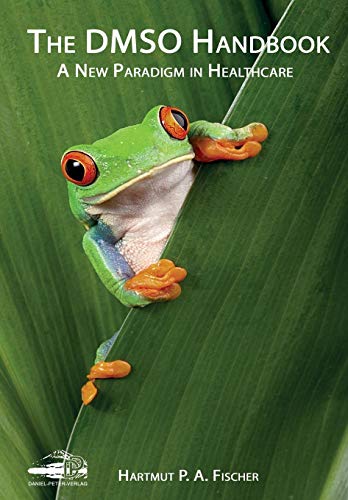Updated on 14. May 2022 from ÁYIO-Q Redaktion
Reading time: approx. 25 minutes
A miracle cure ? – DMSO can really do that !
Doctors, biochemists, physiologists, and pharmacologists are captivated by DMSO, a colourless organic liquid that has long been recognized as an industrial solvent and was discovered by mistake. Despite its basic nature, it travels quickly through the skin and into circulation in record time. In fact, it’s becoming more popular as a liniment for muscular rips, sprains, and bruises, as well as to ease the discomfort of gout and arthritis-related swelling. This article will inform you about all you need to know vis-à-vis the so-called treatment of DMSO.
What exactly is DMSO?
DMSO chemically stands for dimethyl sulfoxide. It is an organosulfur chemical produced as a by-product of the papermaking process, also known as the Kraft process. In particular, during the processing of wood in the production of cellulose pulp, the raw material for the production of paper, cellulose gum, nanocellulose, etc., dimethyl sulfoxide is obtained.
This colourless fluid was quickly discovered to be a polar, aprotic solvent that was miscible with water and capable of dissolving a wide range of polar and nonpolar low molecular weight compounds. It interacts with molecules such as proteins, carbohydrates, lipids, water, and ethanol, and serves as a carrier for medications to pass through the skin since it is a highly polar solvent for many organic and inorganic substances.
Many gases, synthetic fibres, paints, hydrocarbons, salts, and natural materials use DMSO as a laboratory and industrial solvent. It is a common solvent in chemical operations because it is aprotic, generally inert, non-toxic, and stable at high temperatures. Its deuterated form is an excellent solvent for nuclear magnetic resonance spectroscopy.
Although it is now utilised in dermatology, DMSO has the potential to be employed in a far larger range of applications due to its helpful qualities as a penetration-enhancing solvent emulsifier and effective anti-inflammatory pharmacological remedy. As a result, it can be taken orally, applied to the skin, or injected intravenously and is accessible as a prescription medicine and dietary supplement.

According to the Chemical Abstract Service (CAS), other names for DMSO include: [1]
Methane, 1,1′-sulfinylbis-, Methyl sulfoxide, Methane, sulfinylbis-, 1,1′-Sulfinylbis[methane], SQ 9453, DMSO, Dromisol, Dimethyl sulphoxide, Dimexide, Sulfinylbismethane, Dimethyl sulfoxide, Dolicur, DMS 70, DMS 90, Hyadur, Somipront, Infiltrina, Dipirartril-tropico, Demsodrox, Durasorb, Dimexidum, Rimso 50, Syntexan, Gamasol 90, Kemsol, Domoso, Sclerosol, Demavet, Herpid, Demeso, NSC 763, Dimethylsulfoxide, Demasorb, DMSO Evol, Methylsulfinylmethane
DMSO – The Breakthrough

DMSO, like many other contemporary pharmaceutical compounds, has its origins in the mid-to-late nineteenth-century German chemical industry. Alexander Mikhaylovich Zaytsev, a Russian chemist, discovered it in 1866 and published his results in 1867. In the findings, dimethyl sulphur oxide is referred to as “Dimethylschwefeloxyd”. Zaytsev synthesised it about the same time by oxidising methylthiomethane, another kraft process waste, with oxygen or nitrogen dioxide. [2]
Zaytev specialised in organic compounds and developed the Zaitsev rule, which predicts the composition of elimination reaction products. In fact, his synthesis is the foundation for the manufacturing method that is still in use today. Ever since then, DMSO has been extensively explored in the chemical literature.
DMSO – Early Clinical Findings
Polge, Smith, and Parkes were the first to discover that glycerol protects spermatozoa against the harmful effects of freeze – thaw cycles in 1959. Glycerol’s protective effect was discovered to be shared by a variety of other low-molecular-weight neutral solutes, including methanol, acetamide, and glyceryl monoacetate, according to Lovelock. Dimethyl sulphoxide is an alternate solute with a higher permeability to living cells. Their research describes how DMSO protects human and bovine red blood cells, as well as bull spermatozoa, against freezing damage. [3]
In the early 1960s, M.J. Ashwood-Smith made substantial advance on the low-temperature studies already achieved by the prior authors. DMSO, according to the author, can protect mouse bone marrow cells against harm caused by freeze – thaw cycles, as well as short-term storage at -79° C. DMSO is less hazardous to rodents and trypanosomes than glycerol. At preliminary trials, trypanosomes were moving for more than two hours in doses of DMSO ranging from 1% to 50%, but in 50% glycerol, most trypanosomes were dead after just five minutes and all were dead after an hour. [4]
The same year, Ashwood-Smith also discovered that DMSO exhibits radioprotective effects in rodents. A variety of sulfoxides and DMSO derivatives were investigated for radioprotective activity against a fatal dosage of x-rays. Only DMSO, out of the sulfoxides tested, demonstrated significant protective action, providing 70% protection against a deadly dosage of x-rays. During tissue-distribution investigations, it was shown that considerable levels of DMSO were present in testicular material within a short time after injection. This observation raised the potential that DMSO may protect the testes from the effects of x-irradiation, and trials to test this hypothesis were conducted. [5]
Dr Stanley W. Jacob’s organ preservation findings at the beginning of 1964 contributed to pharmacotherapeutic studies by his own laboratory among several other research organizations. Dr Jacob observed in his therapeutic research, both clinical and experimental, that dimethyl sulfoxide successfully penetrates the skin in a group of nine subjects treated for dermatitis with topical DMSO. He actually discovered its skin-penetration property again, since it was already recognised in German chemical science. This sparked a rush of effort evaluating efficacy for various dermatological disorders, with conflicting findings due to poorly understood processes. [6]
As the potential for this unexpected action became clearer, a systematic study of small molecule transport through the skin using DMSO as a carrier began a few months later in 1964. Quantitative tests in vitro and in vivo revealed that DMSO increases human percutaneous absorption of some chemical agents. [7]
By the end of 1964, research on the skin penetrating properties of pharmaceuticals dissolved in DMSO discovered that if it was spilt on the hands, it caused a unique garlic flavour on the tongue, prompting an even more thorough exploration of DMSO as a transport medium for low molecular weight compounds to be delivered through skin and mucosa. [8]
Most of this previous research focused on demonstrating low-temperature protection and skin-penetration effects that were administered locally rather than systemically. According to an early report published in 1965, both subjectively and objectively, cutaneous scleroderma indicated possible potential. Topical therapy many times daily over numerous weeks resulted in significant healing of ischaemic ulcers of the fingers. Scleroderma patients reported increased elasticity of the skin and reduced discomfort, resulting in a larger range of motion. [9]
Subsequently, another clinical study on the use of DMSO in clinical dermatology confirmed previous research. Scleroderma patients saw significant improvements, with their skin becoming soft and ulcers healing. Other dermatoses improved in different ways. Traumatic and bum keloids, hypertrophic scars, atopic eczema, and lichen amyloidosis were among them. Keloids and hypertrophic scars, in particular, flattened after many months of treatment, suggesting therapeutic benefits in dermis-related disorders and illnesses. Acne scarring showed this as well, but not to the same degree since the acne scar was not as severe, to begin with. [10]
DMSO – The FDA “Ban”
Despite thousands of study articles touting its benefits, DMSO went out of popularity in the mid 1960s as the US Food and Drug Administration (FDA) became much more strict following the discovery of limb abnormalities in children born to women who took thalidomide. The FDA commissioned the National Academy of Sciences/National Research Council to investigate the efficacy of forty hundred medications that had only been authorised for safety between 1938 and 1962. The US Congress approved the 1962 Kefauver-Harris Amendments to the 1938 Food, Drug, and Cosmetic Act in response to thalidomide’s effects on embryos both at local and international level. As a result, the FDA put a halt to a lot of it at this point. [11-14]
In 1965, the FDA “banned” DMSO-based clinical trials, merely allowing it to be used for symptomatic relief in patients suffering from interstitial cystitis, since the substance changed the optical properties of laboratory animals’ eye lenses. The experiments were carried out again the following year, but with some limitations to ensure that patients were appropriately safeguarded. After initial interest in the drug diminished, the restriction was repealed in 1980. DMSO was formally classed under FDA-approved drugs once Mylan Institutional’s application was accepted in 2002. [15-19]
DMSO – Mechanisms of Action
The pharmacological impact of DMSO is mediated through a number of biochemical interactions. We’ll look at functional or anatomical alterations at the cellular level as a result of DMSO exposure in live organisms.
Cryoprotectant – Cold-Protective Activity
DMSO has a tissue/organ preservation effect, as evidenced by preliminary clinical investigations undertaken in the early 1960s. We’ll look at some of the factors that cause unprotected freezing and show how cooling may be used to generate stable, life-sustaining conditions.
In cryobiology, DMSO has been employed as a cryoprotectant, and it is still a key component of cryoprotectant vitrification solutions used to preserve organs, tissues, and cell suspensions. Up to 90% of frozen cells will become dormant without it. It’s very significant in the freezing and long-term preservation of embryonic and haematopoietic stem cells, which are frequently frozen in a solution of 10% DMSO, a freezing medium, and 30% foetal bovine serum.
Basile J. Luyet was the first to suggest vitrification for cryobiology uses back in 1937. Matter does not crystallise at extremely low temperatures, according to his works on the vitreous state hypothesis; it crystallises when it is heated up to the crystallisation zone of temperatures. The vitrification process involves quickly cooling below that zone. The vitrification of non-dehydrated protoplasm was viewed as a first step toward a more comprehensive solution to the challenge of storing live matter at low temperatures. Vitrification might be a good way of “fixation” for research such as X-ray study of the final structure of cellular components. [20]
According to a research article in 1985, DMSO was found to be an effective cryoprotectant in the ice-free cryopreservation of mouse embryos at -196 degrees Celsius via vitrification. The concentration of cryoprotectant, as well as the time and temperature of exposure, impact toxicity and osmotic damage. The embryos contracted and then re-expanded to their original sizes, showing that DMSO, acetamide, and propylene glycol were completely absorbed. [21]
A 2007 research adds to the growing body of evidence showing that pore production is a fundamental part of DMSO’s mode of action, which explains DMSO’s considerable boost in membrane penetrability to hydrophilic particles as well as its cryoprotectant effect. Many of DMSO’s pharmacological activities, such as analgesia, protection against ischaemia damage, and cryopreservation, are linked to modulation or interruption of ion or transport of water across a cellular membranes. [22]
In fact, DMSO and other substances are thought to work together to lower the freezing point of water and, more significantly, to induce vitrification, which prevents crystallisation and the harm caused by intracellular ice formation.
In an investigative report conducted in 2011, researchers used molecular dynamics annealing simulations in supercooled water to provide direct computational proof of a widening of the transition temperature of water, correlating to the creation of a stronger glass in liquid DMSO solutions. These observations shed light on the process of solvent cryoprotection at the molecular level, implying that the thermodynamic stability of the glassy state of water lowers the likelihood of nucleation and subsequent ice formation as the temperature drops. [23]
During cryopreservation, osmotic stress was discovered to be a major factor to cell death. Scientists concluded in 2021 that DMSO is still the global standard vitrification substance for a variety of cell types. In fact, while being harmful to cells at significant amounts, vitrification substances such as dimethyl sulfoxide, glycerol, ethylene glycol, or propylene glycol have been found as an essential step in preventing cell death during cryopreservation. [24]
Penetration-Enhancing Activity
As research from the 1960s suggests, DMSO was, and still is, being used in penetration-enhancing solvent excipients. The integration of DMSO, a well-known and frequently used skin penetration booster, in transdermal patches would be highly desirable; yet, due to its volatility, this would be extremely difficult. The researches that follows sheds light on how DMSO accomplishes its penetrating effect.
Skin penetration enhancers are compounds that reversibly reduce the stratum corneum’s barrier resistance. They make it easier for medicines to reach live tissues and so enter the blood stream. Because it enhances the partitioning of active substances into the skin, DMSO is one of the most commonly utilised cosolvents in cosmetology and pharmacology. It improves medication penetration through a variety of processes, including interactions with skin lipids, keratin, and water environment modulation in the outermost layer of the epidermis. For efficient penetration increase, high amounts of DMSO are necessary, which may cause skin irritation. By extending the hypothesis to DMSO, among other compounds, a scientific publication from 1987 established a broad explanation for enhancer action based on probable modifications at the molecular scale of the stratum corneum. [25]
Many substances, including sulfoxides like DMSO, were tested for penetration increasing action in a 2004 review. The processes of sulphoxide penetration enhancers, especially DMSO, were discovered to be complicated. DMSO is commonly used to disintegrate proteins and has been proven to alter intercellular keratin confirmation when applied to human skin. Given its diminutive dimension and strong polarity, it’s possible that DMSO interacts with the head groups of certain bilayer lipids, causing packing geometry distortion. As a result, medication partitioning from a formulation into this “universal solvent” within the tissue may be aided by DMSO within skin membranes. [26]
Another review from 2011 looks into the mechanism of action of DMSO as a pharmacological penetration enhancer, as well as the properties of the molecule that help with transdermal drug delivery and effectiveness and safety investigations. The therapeutic usage of medicinal DMSO as a penetration enhancer is backed up by decades of research proving the substance’s good pharmacological and toxicological profile. The review concluded that DMSO is a safe and effective method for localised drug delivery via transdermal administration of both hydrophilic and lipophilic medications. [27]
The effective increase of hydrophilic substances, such as ions, by DMSO is difficult to explain, according to a 2012 study report on ion transport through DMSO that caused temporary water holes in cell membranes. Ion transport through biological membranes is mediated by at least three components: [28]
- Ion transport is primarily controlled by proteins like ion channels, transporters, and pumps.
- The solubility-diffusion theory suggests that ions partition into the membrane’s hydrophobic core and diffuse across it, allowing ions to flow through.
- Ions are transferred through temporary water pores in the biological membrane, avoiding the high-energy Born barrier of the solubility-diffusion process.
Furthermore, a 2021 pharmaceutics article discusses the viability of a DMSO-based transdermal system with oestradiol as the model medication. The study found that incorporating DMSO into transdermal patches has significant advantages over traditional patch formulations. Although the relation between DMSO content and drug flow for different actives must be validated, it does open the possibility of custom penetration dynamics dependent on the DMSO quantity synthesised in the patch. [29]
Anti-Oxidant Activity
In a variety of biological conditions, DMSO has been proven to have antioxidant effects. For instance, a 1991 study looked at the effects of DMSO on copper-deficient mice’ enlarged hearts. The observation of increased formation of thiobarbituric acid reactive chemicals in stressed mitochondria, as well as the increased generation of breath ethane in copper-deficient animals, all indicate to an oxidative mechanism in lack of copper. As discussed in the research paper, the antioxidant mechanism is one of the other two possibilities for DMSO’s cardiovascular protective activity in copper-deficient rats. [30]
The antioxidant properties of DMSO and its usefulness as a solvent in the assessment of neuroprotective antioxidants were investigated in a research publication released in 2011. In rodent brain homogenates, the results demonstrated that DMSO can prevent both lipid peroxidation and protein carbonyl production caused by ferrous chloride/hydrogen peroxide. Conclusively, the study indicated that DMSO is a highly helpful solvent that may be employed in the creation of additional antioxidants with neuroprotective characteristics at relatively low doses. [31]
Given that prior studies provided proof that DMSO possesses antioxidant properties, a recent scientific paper published in 2018 investigated whether low dosages of DMSO had any effect on cellular Reactive Oxygen Species. Treatment of two separate colon epithelial cell lines with DMSO boosted protein synthesis, reduced esters of cholesterol, and influenced cellular lipid content and oxidation status, according to the findings. [32]
Anti-Inflammatory Activity
The formation of hydroxyl radical by enzymes, chemicals, and human phagocytes in vitro was identified with the application of DMSO, according to a clinical report published in 1979. While the exact mechanism underlying these and many additional DMSO activities was unclear at the time of testing, many of them may involve DMSO scavenging hydroxyl. This is a very enticing notion when it comes to DMSO’s anti-inflammatory properties. Despite the fact that most organisms contain extremely active enzymes for catabolism of hydrogen peroxide and hydroxyl precursors, there are no direct enzymatic methods for elimination of highly reactive hydroxyl. As a result, DMSO’s anti-inflammatory properties may be explained by its reactivity with hydroxyl. [33]
The effectiveness of topical DMSO on tissue regeneration of decubitus ulcers and its usage as an anti-inflammatory medicine were further investigated in a systematic review conducted by Duimel-Peeters in 2003. Both wound healing and analgesia were reported to benefit from the effects. The most common outcome measures were erythema reduction and ulcer healing speed, as well as reduced indications of inflammation such rubor, dolor, calor, and tumor. The valuable findings of DMSO were mostly due to its anti-inflammatory properties, wound healing properties, and, in many cases, pain alleviation. [34-35]
Analgesic Activity
Analgesic activity, or local analgesia, is another pharmacological property of DMSO. The anti-inflammatory properties of DMSO are thought to be responsible for its analgesic properties, making it capable of reducing pain by stopping pain signals from being delivered through nerves.
According to a study released in 2013, DMSO exhibits superoxide dismutase activity. Following that, DMSO can neutralize superoxide radicals, prevent hydroxyl radical-mediated hyaluronan depolymerization, and inhibit prostaglandin formation by oxygen-derived free radicals. Because it inhibits some types of prostaglandins, DMSO is thought to have analgesic properties. When DMSO’s analgesic impact was compared to that of narcotic analgesics, it was discovered to be effective for both acute and chronic musculoskeletal pain. [36]

DMSO – Therapeutic Effect
As it is already known, DMSO has anti-inflammatory, anti-oxidant, and analgesic properties. DMSO also quickly penetrates cellular membranes and is swiftly absorbed and dispersed throughout the body after given via any method. The capacity of DMSO to penetrate membranes may aid in the diffusion of other compounds via the skin. As a result, DMSO is utilized to treat a variety of illnesses and complaints.
Due to its outstanding pharmacological properties, DMSO is used in various therapeutic areas. This is how DMSO works:
- Promotes wound healing,
- immunomodulating
- antibacterial,
- antiviral,
- antifungal
- analgesic,
- muscle relaxant
- vasodilating
- anticoagulant,
- modulates blood lipids and
- antioxidant as a hydroxyl radical scavenger.
The most common uses of DMSO are:
- Rheumatic diseases
- Cystitis
- Disc problems
- Multiple sclerosis
- Cancer
- Dementia
- Osteoporosis
- Osteoarthritis
- Herpes
- Achilles tendinitis
- Gastric ulcers
- Allergies
- Acne
- Throat infections
- Psoriasis
- Sinusitis
Cystitis
Internal cystitis, commonly known as painful bladder syndrome, can be treated with DMSO. The data on DMSO’s effects have been reviewed by Center for Drug Evaluation and Research (CDER) thus making it an FDA-approved drug. Some complaints, such as pain, are relieved by washing the bladder with DMSO.
The majority of the 213 individuals with inflammatory genitourinary diseases investigated in a 1978 research found that DMSO provided considerable alleviation. The authors suggested DMSO for genitourinary inflammatory diseases that were not caused by infection or malignancy and in which patients did not react to standard treatment. There has been no evidence of systemic or local toxicity. Intravesical DMSO treatment is advised in all such patients who have failed to react to traditional forms of therapy or who come with significant symptoms attributable to these chronic inflammatory disorders due to its simplicity and convenience of delivery. [37]
A research article published in 2011 backs up prior investigations. The results indicated that intravesical DMSO suppressed both acute and chronic bladder inflammation in transgenic experimental autoimmune cystitis models. One of the principal therapies for interstitial cystitis patients is intravenous instillation of DMSO, which is one of only two FDA-approved medications for the condition. In the therapy of this unpleasant urinary ailment, this therapeutic strategy has shown to be viable and beneficial. Histological evidence for the impact of intravesical DMSO and a putative mechanism of DMSO action were found in transgenic experimental autoimmune cystitis models. [38]
Amyloidosis
Amyloidosis is a rare disease in which a misfolded protein builds up abnormally in several organs and systems, causing malfunction (heart, kidneys, liver, nervous system, and so on). Amyloidosis can be caused by a number of proteins, but the two most common are primary (AL) and secondary (AA).
The therapeutic potential of DMSO in renal failure induced by amyloidosis was studied in a 1979 research. Two individuals with rheumatoid arthritis-related secondary amyloidosis exhibited a significant improvement in renal function after treatment. The anti-inflammatory impact of DMSO in amyloidosis owing to rheumatoid arthritis appears to be responsible for a reduction in amyloid production. [39]
In a 1989 case report, oral DMSO treatment was explored in two patients with main amyloidosis (AL) and two patients with secondary amyloidosis (AA) due to long-term rheumatoid arthritis. After the first to second trimester of DMSO treatment, individuals with secondary amyloidosis exhibited subjective improvement, a reduction in rheumatoid arthritis inflammatory activity, and an indisputable improvement in renal function. Except for an unpleasant breath odour, DMSO presented no significant adverse effects. The study concluded that oral DMSO therapy may help patients with secondary amyloidosis live longer. [40]
The impact of oral DMSO on amyloid A amyloidosis in chronic inflammatory illness was examined in a retrospective patient chart review from 2006. The study concluded that oral administration of DMSO is an effective therapy for amyloid A amyloidosis, particularly in the early stages of renal impairment and gastrointestinal involvement. This supports previous research findings. [41]
Lastly, according to a case report published in 2013, DMSO-based occlusive dressing treatment for urinary bladder amyloidosis is effective and comfortable. The occlusive dressing therapy technique was simpler and easier than intravesical instillation procedure, and it was favourable in that the patient could do the therapy themselves every day. [42]
There are endless studies that provide more than enough evidence that DMSO has a therapeutic effect and works effectively against different types of amyloidosis.
Herpes
Fascinatingly, DMSO may also have antiviral properties. According to researchers, viral production declines at high DMSO concentrations, and virus protein synthesis is especially hindered under these circumstances.
The therapeutic benefits of 40 percent idoxuridine dissolved in DMSO in acute herpes zoster (shingles) were studied in a double-blind, random selection comparison conducted in 1979. A multivariate correlation analysis found that age was linked to the duration of pain and delayed healing, that quick healing was linked to little or short-term pain, and that zoster in the trigeminal area healed faster than in other areas without being linked to reduced pain. According to the findings, DMSO combined with idoxuridine reduced post-herpetic neuralgia, that is, shingles lesions, edema, and pain dropped when administered to the skin. [43]
Some interesting results were discovered in a 2002 study looking at the influence of DMSO on numerous aspects of herpes simplex virus (HSV) replication. DMSO diminishes viral infection rate, inhibits viral deoxyribonucleic acid (DNA) replication, and lowers HSV-1 gene transcript levels. These data imply that DMSO may have antiherpetic efficacy in and of itself, contradicting earlier assumptions that it solely served as a penetrant for antiviral drugs. [44]
Arthritis
Applying DMSO to the skin may help reduce the symptoms of osteoarthritis and rheumatoid arthritis, as seen in the preliminary research mentioned before.
According to an article released in 2016, DMSO lowers autoimmune arthritis by suppressing inflammatory cytokine production in human blood cells. As a result, DMSO was found to be an effective anti-inflammatory in whole human blood by blocking particular communication pathways in human monocytes during inflammation. At low DMSO concentrations, this is linked to a decrease in the synthesis of inflammatory mediators such growth factors. This, in turn, causes a systemic lowering of white blood cell levels, which contributes to DMSO’s ability to reduce arthritic occurrences. Based on the findings, using DMSO as an anti-inflammatory drug in situations like rheumatoid arthritis has some worth and potential. [45]
Cancer
In 1985, researchers looked at the effects of DMSO on human carcinoma cells, including suppression of plasminogen activator production, changes in cell shape, and changes in response to cholera toxin. After extended in vitro cultivation, human cancer lost its tumorigenic and metastatic capacity. This was accompanied by a decrease in the synthesis of urokinase-type plasminogen activator, which is released by human cancer cells, a change in the responsiveness to effectors that influence urokinase production, and a change in cell shape. When malignant human cancer cells were treated to DMSO, similar but faster alterations occurred. Urokinase activity in the culture media halved the control level within 6 hours of adding DMSO, and it was undetectable after one day’s treatment. According to the findings, the inhibitory impact of DMSO on the generation of plasminogen activator appears to be specific for urokinase in human cell lines. [46]
In epithelial lung cancer cells, DMSO was demonstrated to boost several activities of the tumour suppressor HLJ1 through activator protein-1 activation in a relatively recent study from 2012. The research reveals that overexpression of HLJ1 by DMSO inhibits cancer cell invasion, migration, proliferation, and colony formation in a concentration-dependent way, but ethanol had no impact. The findings imply that DMSO may be a significant activator of the tumour suppressor protein HLJ1 in highly invasive lung cancer cells via AP-1 activation. Targeted induction of HLJ1 is a promising cancer therapeutic method, which suggests that DMSO might be used as a lead chemical or coordinated ligand in the creation of new anticancer medicines. [47]
DMSO – Side Effects
According to a systematic review of DMSO’s adverse effects in humans, DMSO can induce a small range of adverse effects, the most of which are temporary and moderate. The amount of DMSO used has a significant impact on the occurrence of adverse effects. In small dosages, DMSO appears to be safe. The side effects reported include the following: [48]
- Nausea
- Vomiting
- Abdominal cramps/stomach ache
- Halitosis/garlicky breath
- Diarrhoea
DMSO – Applications
Topical Solution
When DMSO is used in conjunction with drugs that are applied to the skin, eyes, or ears, the amount of medicine absorbed by the body is increased. Increasing the amount of medication absorbed by the body may enhance the medicine’s effects and adverse effects.
For the external application of DMSO on the skin, we recommend the following concentrations:
| Application site | DMSO solution | Additions |
|---|---|---|
| Feet/legs, arms/hands, trunk area | 70% | gladly also with MgCl |
| Face | 30% | gladly also with MgCl |
| Open skin areas | 25% | – |
| Mucous membranes and intimate areas | 25% | – |
| Dabbing skin warts | 99,9% | – |
| Ear/nose drops | 15% | – |
| Eye drops | 3% | – |
Remember that itching may occur after the application of DMSO. This is a typical skin reaction and should subside within a few minutes. For sensitive people or if the recommended percentage seems too high, we recommend diluting the DMSO solution with laboratory water.
Considering the fact that DMSO has infiltrating and also efficacy-enhancing properties, direct contact with foreign substances that are of concern to health and well-being must be avoided while taking DMSO.
Oral Solution
Taking DMSO with oral drugs may enhance the amount of medicine absorbed by the body. Increasing the amount of medication absorbed by the body can enhance the medication’s benefits and adverse effects.
For the internal use of DMSO, 60-70% DMSO solution with MgCl (magnesium chloride) is recommended.
Through a targeted selection of medicinal plants, DMSO can enhance the desired effect of the medicinal plant and transport it right into the cell nucleus. This is in addition to the effect of DMSO on the cells. The dosages and use can be discussed with your herbalist, your therapist or can be found in the literature.
Intravenous solution
Combining DMSO with injectable pharmaceuticals may enhance the amount of medicine absorbed by the body, as well as the benefits and negative effects of medications given as a shot.
For intravenous treatment, please talk to your doctor or therapist.
5 Principles, for a risk-free use as well as a positive result of DMSO
- Store DMSO only at room temperature
- The compound should not come into contact with plastic surfaces (attacks the surface of the plastic, liquefies plasticisers).
- Dilute it with sufficient water for large-area, external application.
- Clean the skin before external application
- Clean the skin to avoid the typical tingling, itching or burning sensation that may occur during use
Depending on how much DMSO you have actually used, you may notice an odour reminiscent of garlic in the exhaled air. The sulphidic smell is due to the metabolic processes and can last up to 120 hours after application.

The many possible ways of using DMSO pure or dissolved, both internally and externally, must always be done in the correct solution ratio. Information on the individual solutions and applications can be found in the:
DMSO-Handbook by Dr.rer.nat. Hartmut Fischer.
ADS:
(Note: As an Amazon affiliate, we earn on qualifying sales).
Sources:
[1] Dimethyl sulfoxide. CAS Common Chemistry. CAS, a division of the American Chemical Society, n.d. Available at: https://commonchemistry.cas.org/detail?cas_rn=67-68-5 (retrieved 2022-06-04) (CAS RN: 67-68-5).
[2] Saytzeff A. “Über die Einwirkung von Saltpetersäure auf Schwefelmethyl und Schwefeläthyl” (On the effect of nitric acid on methyl sulfide and ethyl sulfide). Annalen der Chemie und Pharmacie 1867;144:148–56. Erhältlich unter: https://books.google.al/books?id=uelSAAAAcAAJ&lpg=PA148&pg=PA148
[3] LOVELOCK, J E, and M W BISHOP. “Prevention of freezing damage to living cells by dimethyl sulphoxide.” Nature vol. 183,4672 (1959): 1394-5. doi:10.1038/1831394a0. Erhältlich unter: https://www.nature.com/articles/1831394a0
[4] WALKER, P J, and M J ASHWOOD-SMITH. “Dimethyl sulphoxide, an alternative to glycerol, for the low-temperature preservation of trypanosomes.” Annals of tropical medicine and parasitology vol. 55 (1961): 93-6. doi:10.1080/00034983.1961.11686023. Erhältlich unter: https://www.tandfonline.com/doi/abs/10.1080/00034983.1961.11686023
[5] M.J. Ashwood-Smith. “The radioprotective action of dimethyl sulphoxide and various other sulphoxides.” International journal of radiation biology and related studies in physics, chemistry, and medicine vol. 3 (1961): 41-8. doi:10.1080/09553006114550051. Erhältlich unter: https://www.tandfonline.com/doi/abs/10.1080/09553006114550051
[6] JACOB SW, BISCHEL M, HERSCHLER RJ. DIMETHYL SULFOXIDE (DMSO): A NEW CONCEPT IN PHARMACOTHERAPY. Current therapeutic research, clinical and experimental. 1964;6:134-135. Erhältlich unter: http://www.scopus.com/inward/record.url?scp=0000186422&partnerID=8YFLogxK
[7] STOUGHTON RB, FRITSCH W. Influence of Dimethylsulfoxide (DMSO): On Human Percutaneous Absorption. Arch Dermatol. 1964;90(5):512–517. doi:10.1001/archderm.1964.01600050060012. Erhältlich unter: https://jamanetwork.com/journals/jamadermatology/article-abstract/528925
[8] HORITA, A, and L J WEBER. “SKIN PENETRATING PROPERTY OF DRUGS DISSOLVED IN DIMETHYLSULFOXIDE (DMSO) AND OTHER VEHICLES.” Life sciences (1962) vol. 3 (1964): 1389-95. doi:10.1016/0024-3205(64)90079-7. Erhältlich unter: https://www.sciencedirect.com/science/article/abs/pii/0024320564900797
[9] SCHERBEL, A L et al. “ALTERATION OF COLLAGEN IN GENERALIZED SCLERODERMA (PROGRESSIVE SYSTEMIC SCLEROSIS) AFTER TREATMENT WITH DIMETHYL SULFOXIDE: PRELIMINARY REPORT.” Cleveland Clinic quarterly vol. 32 (1965): 47-56. doi:10.3949/ccjm.32.2.47. Erhältlich unter: https://www.ccjm.org/content/ccjom/32/2/47.full.pdf
[10] Engel, M F. “Dimethyl sulfoxide (DMSO) in clinical dermatology.” Southern medical journal vol. 59,11 (1966): 1318-9. doi:10.1097/00007611-196611000-00015. Erhältlich unter: https://pubmed.ncbi.nlm.nih.gov/5333579/
[11] U.S. Food and Drug Administration. Milestones in U.S. Food and Drug Law. Content current as of 31 of January, 2018. Erhältlich unter: https://www.fda.gov/about-fda/fda-history/milestones-us-food-and-drug-law
[12] Blauberman, Scott. “The Real Thalidomide Baby: The Evolution of the FDA in the Shadow of Thalidomide, 1960–1997.” Digital Access to Scholarship at Harvard (1997). Available at http://nrs.harvard.edu/urn-3:HUL.InstRepos:8852132
[13] Drug Efficacy Amendment of 1962. Public Law 87-781, 76 § 780 (1062). Available at: http://www.gpo.gov/fdsys/pkg/STATUTE-76/pdf/STATUTE-76-Pg780.pdf
[14] Federal Food, Drug, and Cosmetics Act of 1938. Public Law 75-717, 52 § 1040 (1938). Available at: http://research.archives.gov/description/299847
[15] U.S. Food and Drug Administration. Import Alert 62-06. Archived from www.accessdata.fda.gov on 12/08/2012. Retrieved 07/05/2022. Erhältlich unter: https://web.archive.org/web/20120808235241/http://www.accessdata.fda.gov/cms_ia/importalert_169.html
[16] DMSO Ban: Was It Handled Properly? Journal of the American Medical Association. 1966;195(1):A33–A34. doi:10.1001/jama.1966.03100010017005. Erhältlich unter: https://jamanetwork.com/journals/jama/article-abstract/657556
[17] FDA set to approve DMSO for human use. Chemical & Engineering News Archive. 1978, 56 (13), 6. doi:10.1021/cen-v056n013.p006. Erhältlich unter: https://pubs.acs.org/doi/10.1021/cen-v056n013.p006
[18] Phillip. W. Davis, An Incipient “Wonder Drug” Movement: DMSO and the Food and Drug Administration, Social Problems, Volume 32, Issue 2, 1 December 1984, Pages 197–212, doi:10.2307/800788. Erhältlich unter: https://academic.oup.com/socpro/article-abstract/32/2/197/1701775
[19] U.S. Food and Drug Administration. FDA-Approved Drugs. Abbreviated New Drug Application (ANDA): 076185. Erhältlich unter: https://www.accessdata.fda.gov/scripts/cder/daf/index.cfm?event=overview.process&ApplNo=076185
[20] Luyet BJ. The vitrification of organic colloids and of protoplasm. Bio dynamica. 1937;1(29):1–14. Erhältlich unter: https://www.sciencedirect.com/science/article/abs/pii/S0011224066800329
[21] Rall, W F, and G M Fahy. “Ice-free cryopreservation of mouse embryos at -196 degrees C by vitrification.” Nature vol. 313,6003 (1985): 573-5. doi:10.1038/313573a0. Erhältlich unter: https://www.nature.com/articles/313573a0
[22] Gurtovenko, Andrey A, and Jamshed Anwar. “Modulating the structure and properties of cell membranes: the molecular mechanism of action of dimethyl sulfoxide.” The journal of physical chemistry. B vol. 111,35 (2007): 10453-60. doi:10.1021/jp073113e. Erhältlich unter: https://pubs.acs.org/doi/10.1021/jp073113e
[23] Mandumpal, Jestin B et al. “A molecular mechanism of solvent cryoprotection in aqueous DMSO solutions.” Physical chemistry chemical physics : PCCP vol. 13,9 (2011): 3839-42. doi:10.1039/c0cp02326d. Erhältlich unter: https://pubs.rsc.org/en/content/articlelanding/2011/CP/c0cp02326d
[24] Whaley D, Damyar K, Witek RP, Mendoza A, Alexander M, Lakey JR. Cryopreservation: An Overview of Principles and Cell-Specific Considerations. Cell Transplant. 2021;30:963689721999617. doi:10.1177/0963689721999617. Erhältlich unter: https://journals.sagepub.com/doi/full/10.1177/0963689721999617
[25] B.W. Barry. “Mode of action of penetration enhancers in human skin”. Journal of Controlled Release. Volume 6, Issue 1 (1987). Pages 85-97. ISSN 0168-3659. doi:10.1016/0168-3659(87)90066-6. Erhältlich unter: https://www.sciencedirect.com/science/article/pii/0168365987900666
[26] Williams, Adrian C, and Brian W Barry. “Penetration enhancers.” Advanced drug delivery reviews vol. 56,5 (2004): 603-18. doi:10.1016/j.addr.2003.10.025. Erhältlich unter: https://linkinghub.elsevier.com/retrieve/pii/S0169409X03002412
[27] Marren, Karrie. “Dimethyl sulfoxide: an effective penetration enhancer for topical administration of NSAIDs.” The Physician and sportsmedicine vol. 39,3 (2011): 75-82. doi:10.3810/psm.2011.09.1923. Erhältlich unter: https://www.tandfonline.com/doi/pdf/10.3810/psm.2011.09.1923
[28] He, Fei et al. “Ion transport through dimethyl sulfoxide (DMSO) induced transient water pores in cell membranes.” Molecular membrane biology vol. 29,3-4 (2012): 107-13. doi:10.3109/09687688.2012.687460. Erhältlich unter: https://www.tandfonline.com/doi/full/10.3109/09687688.2012.687460
[29] Otterbach, Anna, and Alf Lamprecht. “Enhanced Skin Permeation of Estradiol by Dimethyl Sulfoxide Containing Transdermal Patches.” Pharmaceutics vol. 13,3 320. 1 Mar. 2021, doi:10.3390/pharmaceutics13030320. Erhältlich unter: https://www.mdpi.com/1999-4923/13/3/320
[30] Saari, J T, and D M Medeiros. “Effect of dimethyl sulfoxide on enlarged hearts of copper-deficient rats.” Biological trace element research vol. 31,3 (1991): 249-63. doi:10.1007/BF02990195. Erhältlich unter: https://link.springer.com/article/10.1007/BF02990195
[31] Sanmartín-Suárez, Carolina et al. “Antioxidant properties of dimethyl sulfoxide and its viability as a solvent in the evaluation of neuroprotective antioxidants.” Journal of pharmacological and toxicological methods vol. 63,2 (2011): 209-15. doi:10.1016/j.vascn.2010.10.004. Erhältlich unter: https://linkinghub.elsevier.com/retrieve/pii/S1056-8719(10)00162-0
[32] Tunçer, S., Gurbanov, R., Sheraj, I. et al. Low dose dimethyl sulfoxide driven gross molecular changes have the potential to interfere with various cellular processes. Sci Rep 8,14828 (2018). doi:10.1038/s41598-018-33234-z. Erhältlich unter: https://www.nature.com/articles/s41598-018-33234-z
[33] Repine, J E et al. “Generation of hydroxyl radical by enzymes, chemicals, and human phagocytes in vitro. Detection with the anti-inflammatory agent, dimethyl sulfoxide.” The Journal of clinical investigation vol. 64,6 (1979): 1642-51. doi:10.1172/JCI109626. Erhältlich unter: https://www.jci.org/articles/view/109626
[34] Duimel-Peeters, Halfens RJ, Snoeckx LH, et al. A systematic review of the efficacy of topical skin application of dimethyl sulfoxide on wound healing and as an anti-inflammatory drug. Wounds. 2003;15(11):361–370. Erhältlich unter: https://www.researchgate.net/profile/Ronald-Houwing/publication/12489799_Pressure-induced_skin_lesions_in_pigs_reperfusion_injury_and_the_effects_of_vitamin_E/links/0912f5098fe8811941000000/Pressure-induced-skin-lesions-in-pigs-reperfusion-injury-and-the-effects-of-vitamin-E.pdf#page=68
[35] Ciaccia L. (2011). Fundamentals of Inflammation. The Yale Journal of Biology and Medicine, 84(1), 64–65. Erhältlich unter: https://www.ncbi.nlm.nih.gov/pmc/articles/PMC3064252/pdf/yjbm_84_1_64a.pdf
[36] Carl A. Kirker-Head, Hillary Feldmann. 23 – Pharmacotherapy of joint and tendon disease. Editor(s): Kenneth W. Hinchcliff, Andris J. Kaneps, Raymond J. Geor. Equine Sports Medicine and Surgery (Second Edition). W.B. Saunders. 2014. Pages 473-502. ISBN 9780702047718. doi:10.1016/B978-0-7020-4771-8.00023-5. Erhältlich unter: https://www.sciencedirect.com/science/article/pii/B9780702047718000235
[37] Shirley, S W et al. “Dimethyl sulfoxide in treatment of inflammatory genitourinary disorders.” Urology vol. 11,3 (1978): 215-20. doi:10.1016/0090-4295(78)90118-8. Erhältlich unter: https://www.dmso.org/articles/bladder/bladder1.htm
[38] Kim R, Liu W, Chen X, Kreder KJ, Luo Y. Intravesical dimethyl sulfoxide inhibits acute and chronic bladder inflammation in transgenic experimental autoimmune cystitis models. J Biomed Biotechnol. 2011;2011:937061. doi:10.1155/2011/937061. Erhältlich unter: https://www.ncbi.nlm.nih.gov/pmc/articles/PMC2989383/pdf/JBB2011-937061.pdf
[39] M H van Rijswijk. “Treatment of renal amyloidosis with dimethylsulphoxide (DMSO).” Proceedings of the European Dialysis and Transplant Association. European Dialysis and Transplant Association vol. 16 (1979): 500-5. Erhältlich unter: https://europepmc.org/article/med/548994
[40] Morassi, P et al. “Trattamento dell’amiloidosi con dimetilsulfossido (DMSO)” [Treatment of amyloidosis with dimethyl sulfoxide (DMSO)]. Minerva medica vol. 80,1 (1989): 65-70. Erhältlich unter: https://europepmc.org/article/med/2915815
[41] Amemori, Sadahiro et al. “Oral dimethyl sulfoxide for systemic amyloid A amyloidosis complication in chronic inflammatory disease: a retrospective patient chart review.” Journal of gastroenterology vol. 41,5 (2006): 444-9. doi:10.1007/s00535-006-1792-3. Erhältlich unter: https://link.springer.com/article/10.1007/s00535-006-1792-3
[42] Yoshino, T., Ohara, S. & Moriyama, H. Occlusive dressing therapy using dimethyl sulfoxide in a patient presenting with primary localized amyloidosis of the urinary bladder: a case report. J Med Case Reports 7, 191 (2013). doi:10.1186/1752-1947-7-191. Erhältlich unter: https://jmedicalcasereports.biomedcentral.com/articles/10.1186/1752-1947-7-191
[43] Wildenhoff, K E et al. “Treatment of herpes zoster with idoxuridine ointment, including a multivariate analysis of symptoms and signs.” Scandinavian journal of infectious diseases vol. 11,1 (1979): 1-9. doi:10.3109/inf.1979.11.issue-1.01. Erhältlich unter: https://www.tandfonline.com/doi/abs/10.3109/inf.1979.11.issue-1.01
[44] Aguilar JS, Roy D, Ghazal P, Wagner EK. Dimethyl sulfoxide blocks herpes simplex virus-1 productive infection in vitro acting at different stages with positive cooperativity. Application of micro-array analysis. BMC Infect Dis. 2002;2:9. Published 2002 May 24. doi:10.1186/1471-2334-2-9. Erhältlich unter: https://bmcinfectdis.biomedcentral.com/articles/10.1186/1471-2334-2-9
[45] Elisia I, Nakamura H, Lam V, et al. DMSO Represses Inflammatory Cytokine Production from Human Blood Cells and Reduces Autoimmune Arthritis. PLoS One. 2016;11(3):e0152538. Published 2016 Mar 31. doi:10.1371/journal.pone.0152538. Erhältlich unter: https://journals.plos.org/plosone/article?id=10.1371/journal.pone.0152538
[46] Ossowski, L, and D Belin. “Effect of dimethyl sulfoxide on human carcinoma cells, inhibition of plasminogen activator synthesis, change in cell morphology, and alteration of response to cholera toxin.” Molecular and cellular biology vol. 5,12 (1985): 3552-9. doi:10.1128/mcb.5.12.3552-3559.1985. Erhältlich unter: https://journals.asm.org/doi/10.1128/mcb.5.12.3552-3559.1985
[47] Wang, Chi-Chung et al. “Dimethyl sulfoxide promotes the multiple functions of the tumor suppressor HLJ1 through activator protein-1 activation in NSCLC cells.” PloS one vol. 7,4 (2012): e33772. doi:10.1371/journal.pone.0033772. Erhältlich unter: https://journals.plos.org/plosone/article?id=10.1371/journal.pone.0033772
[48] Kollerup Madsen B, Hilscher M, Zetner D, Rosenberg J. Adverse reactions of dimethyl sulfoxide in humans: a systematic review. F1000Res. 2018;7:1746. Published 2018 Nov 5. doi:10.12688/f1000research.16642.2. Erhältlich unter: https://www.ncbi.nlm.nih.gov/pmc/articles/PMC6707402/pdf/f1000research-7-22126.pdf















